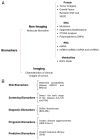Promising predictive molecular biomarkers for cervical cancer (Review)
- PMID: 38606495
- PMCID: PMC11090266
- DOI: 10.3892/ijmm.2024.5374
Promising predictive molecular biomarkers for cervical cancer (Review)
Abstract
Cervical cancer (CC) constitutes a serious public health problem. Vaccination and screening programs have notably reduced the incidence of CC worldwide by >80%; however, the mortality rate in low‑income countries remains high. The staging of CC is a determining factor in therapeutic strategies: The clinical management of early stages of CC includes surgery and/or radiotherapy, whereas radiotherapy and/or concurrent chemotherapy are the recommended therapeutic strategies for locally advanced CC. The histopathological characteristics of tumors can effectively serve as prognostic markers of radiotherapy response; however, the efficacy rate of radiotherapy may significantly differ among cancer patients. Failure of radiotherapy is commonly associated with a higher risk of recurrence, persistence and metastasis; therefore, radioresistance remains the most important and unresolved clinical problem. This condition highlights the importance of precision medicine in searching for possible predictive biomarkers to timely identify patients at risk of treatment response failure and provide tailored therapeutic strategies according to genetic and epigenetic characteristics. The present review aimed to summarize the evidence that supports the role of several proteins, methylation markers and non‑coding RNAs as potential predictive biomarkers for CC.
Keywords: DNA methylation; cervical cancer; non‑coding RNAs; predictive biomarkers; treatment.
Conflict of interest statement
The authors declare that they have no competing interests.
Figures


Similar articles
-
SEOM guidelines for cervical cancer.Clin Transl Oncol. 2015 Dec;17(12):1036-42. doi: 10.1007/s12094-015-1452-2. Epub 2015 Dec 9. Clin Transl Oncol. 2015. PMID: 26650487 Free PMC article.
-
SEOM guidelines for cervical cancer.Clin Transl Oncol. 2012 Jul;14(7):516-9. doi: 10.1007/s12094-012-0834-y. Clin Transl Oncol. 2012. PMID: 22721796
-
SEOM clinical guidelines for cervical cancer (2019).Clin Transl Oncol. 2020 Feb;22(2):270-278. doi: 10.1007/s12094-019-02271-z. Epub 2020 Jan 24. Clin Transl Oncol. 2020. PMID: 31981078
-
Roles of long non-coding RNAs in cervical cancer.Life Sci. 2020 Sep 1;256:117981. doi: 10.1016/j.lfs.2020.117981. Epub 2020 Jun 17. Life Sci. 2020. PMID: 32561395 Review.
-
Molecular landscape of recurrent cervical cancer.Crit Rev Oncol Hematol. 2021 Jan;157:103178. doi: 10.1016/j.critrevonc.2020.103178. Epub 2020 Nov 18. Crit Rev Oncol Hematol. 2021. PMID: 33279812 Review.
Cited by
-
Comprehensive analysis of mRNA and lncRNA expression for predicting lymph node metastasis in cervical cancer: a novel seven-gene signature approach.Front Genet. 2025 May 15;16:1524821. doi: 10.3389/fgene.2025.1524821. eCollection 2025. Front Genet. 2025. PMID: 40444278 Free PMC article.
-
DNA methyltransferase DNMT3A inhibits TP53AIP1 expression and promotes cervical cancer development and metastasis.Cytotechnology. 2025 Apr;77(2):74. doi: 10.1007/s10616-025-00735-5. Epub 2025 Mar 7. Cytotechnology. 2025. PMID: 40062226
-
The role of long noncoding RNA SNHG29 in malignant tumors.Discov Oncol. 2025 Jul 15;16(1):1334. doi: 10.1007/s12672-025-03189-5. Discov Oncol. 2025. PMID: 40663245 Free PMC article. Review.
-
Emerging roles of long non-coding RNA FOXP4-AS1 in human cancers: From molecular biology to clinical application.Heliyon. 2024 Oct 26;10(21):e39857. doi: 10.1016/j.heliyon.2024.e39857. eCollection 2024 Nov 15. Heliyon. 2024. PMID: 39539976 Free PMC article. Review.
-
Curcumin enhances ATG3-dependent autophagy and inhibits metastasis in cervical carcinoma.Cell Div. 2024 Nov 28;19(1):33. doi: 10.1186/s13008-024-00138-6. Cell Div. 2024. PMID: 39609925 Free PMC article.
References
-
- The International Agency for Research on Cancer GLOBOCAN 2020: New Global Cancer Data. [Accessed December 17 2020]. https://www.uicc.org/news/globocan-2020-new-global-cancer-data .
-
- Falcaro M, Castañon A, Ndlela B, Checchi M, Soldan K, Lopez-Bernal J, Elliss-Brookes L, Sasieni P. The effects of the national HPV vaccination programme in England, UK, on cervical cancer and grade 3 cervical intraepithelial neoplasia incidence: A register-based observational study. Lancet. 2021;398:2084–2092. doi: 10.1016/S0140-6736(21)02178-4. - DOI - PubMed

